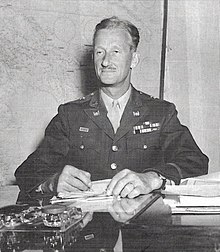Leif J. Sverdrup | |
|---|---|
 Sverdrup in 1944 | |
| Birth name | Leif Johan Sverdrup |
| Nickname(s) | Jack |
| Born | 11 January 1898 Ytre Sula, Solund, Norway |
| Died | 2 January 1976 (aged 77) St. Louis, Missouri, U.S. |
| Buried | Valhalla Cemetery, St Louis, Missouri |
| Allegiance | |
| Service | |
| Years of service | 1918–1919 1942–1958 |
| Rank | |
| Service number | O-129029 |
| Commands | |
| Battles / wars | World War I World War II |
| Awards | Distinguished Service Cross Distinguished Service Medal Silver Star Legion of Merit Purple Heart Commander of the Order of the British Empire (Australia) |
| Other work | Sverdrup & Parcel |
Leif Johan Sverdrup CBE (11 January 1898 – 2 January 1976) was a Norwegian-born American civil engineer and general with the U.S. Army Corps of Engineers in the first half of the 20th century. He is best known for his service in the Southwest Pacific Area during World War II where he was Chief Engineer under General of the Army Douglas MacArthur.
The son of a distinguished Norwegian family, Sverdrup emigrated to the United States in 1914. After serving with the US Army in World War I, he earned a degree in civil engineering at the University of Minnesota in 1921. He worked for a time for the Missouri State Highway Department before founding Sverdrup & Parcel, a civil engineering firm specializing in bridge construction, with John Ira Parcel, his former University of Minnesota engineering professor. His firm was involved in the construction of a number of important bridges, including the Washington Bridge and Amelia Earhart Bridge over the Missouri River and the Hurricane Deck Bridge over the Lake of the Ozarks.
In 1941, Sverdrup became involved with the construction of a chain of airstrips across the Pacific Ocean to enable heavy bombers to be delivered to the Philippines. He was re-commissioned in the US Army as a colonel in 1942 and became Chief of the Construction Section in General MacArthur's Southwest Pacific Area. In 1942 he made three treks across the Owen Stanley Range in Papua and New Guinea on engineer reconnaissance missions into enemy-occupied territory, for which he was decorated with the Silver Star and the Distinguished Service Medal. In 1944 he became the theater's Chief Engineer.
After the war, he commanded the 102nd Infantry Division of the US Army Reserve from 1947 to 1958. Sverdrup & Parcel went on to design and oversee the construction of many major projects, including the Arnold Engineering Development Center and the Chesapeake Bay Bridge-Tunnel, the latter being named one of the Seven Engineering Wonders of the Modern World after its completion in 1964.